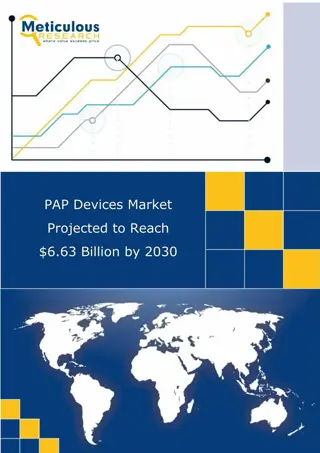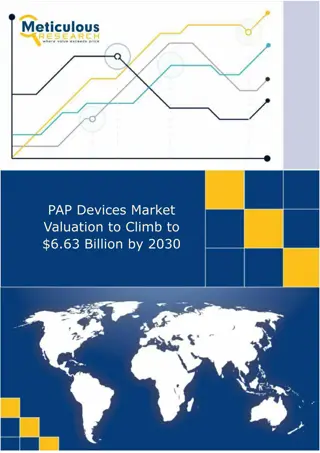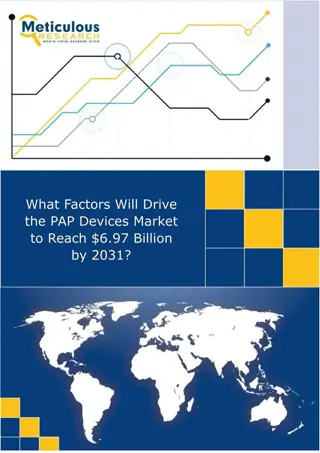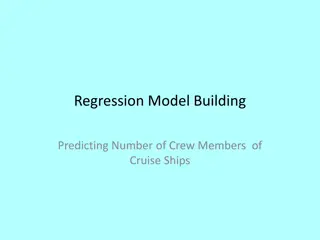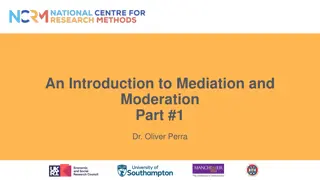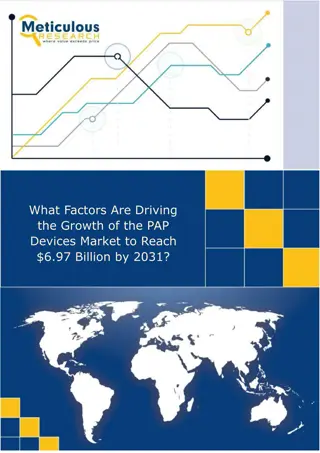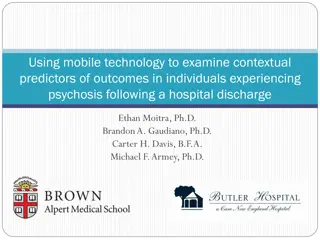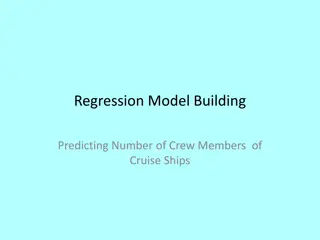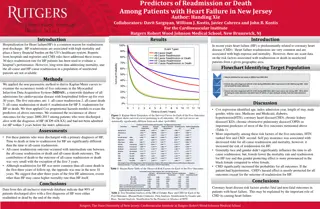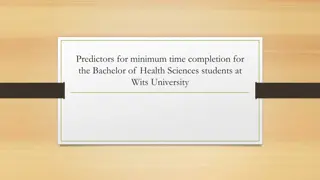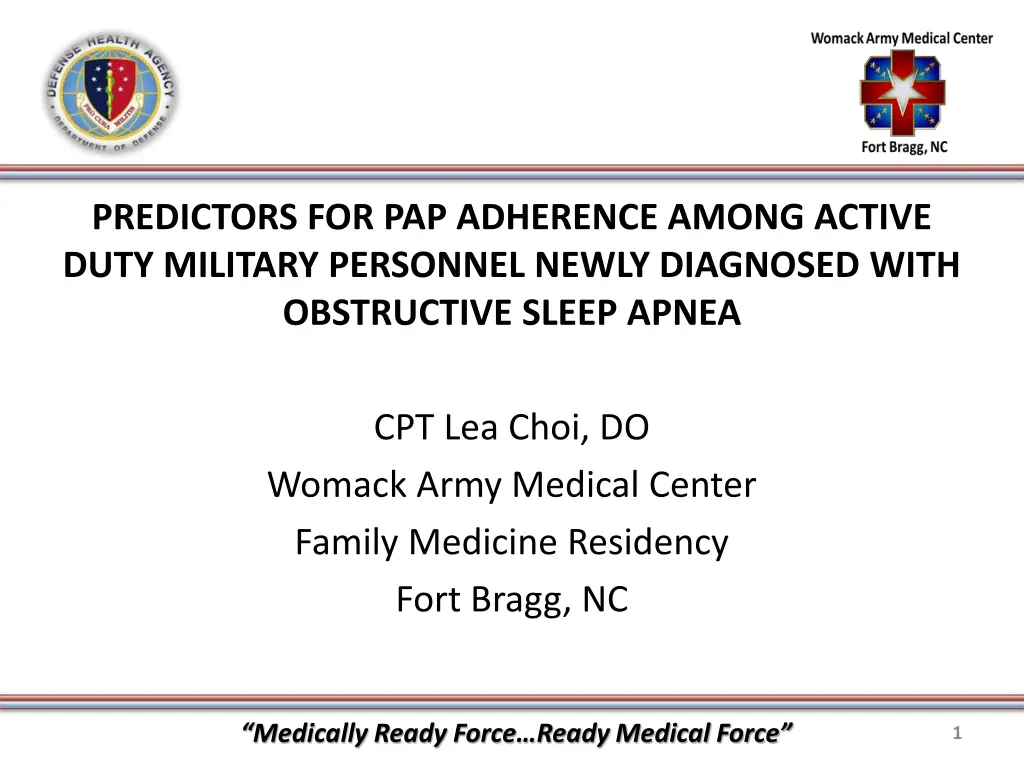
Predictors for PAP Adherence Among Military Personnel with Sleep Apnea
Explore predictors of adherence to PAP therapy among newly diagnosed military personnel with obstructive sleep apnea, including comorbid conditions like PTSD, depression, and insomnia. Discover the impact of OSA severity on adherence rates and potential implications for long-term health outcomes.
Download Presentation

Please find below an Image/Link to download the presentation.
The content on the website is provided AS IS for your information and personal use only. It may not be sold, licensed, or shared on other websites without obtaining consent from the author. If you encounter any issues during the download, it is possible that the publisher has removed the file from their server.
You are allowed to download the files provided on this website for personal or commercial use, subject to the condition that they are used lawfully. All files are the property of their respective owners.
The content on the website is provided AS IS for your information and personal use only. It may not be sold, licensed, or shared on other websites without obtaining consent from the author.
E N D
Presentation Transcript
PREDICTORS FOR PAP ADHERENCE AMONG ACTIVE DUTY MILITARY PERSONNEL NEWLY DIAGNOSED WITH OBSTRUCTIVE SLEEP APNEA CPT Lea Choi, DO Womack Army Medical Center Family Medicine Residency Fort Bragg, NC Medically Ready Force Ready Medical Force 1
Disclosures The views expressed herein are those of the presenter and do not necessarily reflect the official policy of the Department of the Army, Department of Defense, or the United States Government. The presenter and project team members have no financial disclosures associated with this project. Medically Ready Force Ready Medical Force 2
Project Team CPT Lea Choi, DO Juliana S. Ee, PhD Christopher K. Pham, DO MAJ David P. Shaha, MD Mary C. Rogers, RN Greg S. Cacace, RPSGT CPT Charles Mounts, DO CPT Anna C. Sealander, MD Nina Pogorzelski, BS Yuliang Liu, PhD Medically Ready Force Ready Medical Force 3
Background Obstructive sleep apnea (OSA) is the most common type of sleep breathing disorder Caused by physical blockage of the airway Characterized by sleep-related decreases or pauses in respiration Clinical symptoms of OSA: daytime sleepiness, loud snoring, witnessed apneas, awakenings due to gasping and choking Physical findings: obesity, hypertension, large neck circumference, crowded oropharyngeal airway Medically Ready Force Ready Medical Force 4
Background Diagnosis of OSA includes an overnight polysomnography Treatment of OSA with positive airway pressure (PAP) therapy effectively relieves the upper airway obstruction Untreated OSA is associated with multiple negative outcomes Long-term health problems: cardiovascular disease, cardiac arrhythmia, heart failure, hypertension, cerebrovascular disease, diabetes, mood disorders Cognitive impairments: executive functioning, working memory, sustained attention, visuospatial learning Economic and healthcare costs Medically Ready Force Ready Medical Force 5
Military Population Prevalence of OSA: 51.2% PAP adherence: 25.2% (PTSD); 58.3% (without PTSD) Predictors of adherence examined: comorbid PTSD, depression, insomnia, OSA severity Medically Ready Force Ready Medical Force 6
Project Aim To identify predictors of PAP therapy adherence in active duty military personnel diagnosed with OSA and prescribed PAP therapy Medically Ready Force Ready Medical Force 7
Materials and Methods Project design: Retrospective cross-sectional analysis Participants: 239 active duty service members 94% men; 73% enlisted Procedure: Soldiers with newly diagnosed OSA and prescribed PAP therapy were invited to attend an interactive 90-minute behavioral intervention forum Aim: To enhance PAP therapy adherence Facilitators: Sleep medicine physician, Psychologist Structure: Discuss knowledge, skills, and attitudes for successful PAP therapy Handouts: Self-assessment tools, Treatment action worksheet Medically Ready Force Ready Medical Force 8
Materials and Methods Self-assessment tools to facilitate active forum discussion Sleep trouble: difficulty falling asleep, difficulty staying asleep, early morning awakening Sleep distress: being worried, not satisfied with sleep pattern Sleep affects functioning: sleep problem interfering with daily functioning, trouble staying awake while driving Mood difficulty: PHQ-4 (Patient Health Questionnaire) Stress appraisal: PSS-4 (Perceived Stress Scale) Risk perception, Outcome expectancies, and Treatment self-efficacy: SEMSA (Self-Efficacy Measure of Sleep Apnea) How Ready, Important, Confident about PAP therapy Medically Ready Force Ready Medical Force 9
Results Analytic sample: 239 out of 300 forum participants Demographics: 94% men, 73% enlisted Predictor variables: self-assessment tools and treatment action worksheet Criterion variables Average number of days of PAP use 4 hours per night for 30 consecutive days Average hours of PAP use on days used Medically Ready Force Ready Medical Force 10
Results Predictor variables Predictors Age (years) Apnea-Hypopnea Index Sleep Trouble Sleep Distress Sleep Affects Function Mood Difficulty (PHQ-4) Stress Appraisal (PSS-4) Risk Perception Outcome Expectancies Treatment Self-Efficacy How Important How Ready How Confident Mean 40.0 15.2 4.8 3.1 2.4 3.4 4.8 17.8 28.0 28.2 9.3 9.1 8.5 SD 7.8 13.6 2.4 1.9 1.6 3.5 3.4 5.1 5.5 5.9 1.2 1.4 1.5 Range 20 to 63 5 to 106 0 to 9 0 to 6 0 to 6 0 to 12 0 to 16 8 to 31 9 to 36 9 to 36 1 to 10 1 to 10 1 to 10 Medically Ready Force Ready Medical Force 11
Results Criterion variables PAP Use 4 hours Mean SD First 30 days (30-day mark) 52.0% 34.1% 15.6 / 30 days Second 30 days (60-day mark) 49.8% 33.8% 14.9 / 30 days Sixth 30 days (180-day mark) 47.1% 32.5% 14.1 / 30 days Average usage on days used Mean SD First 30 days (30-day mark) 4.9 hours 2.0 hours Second 30 days (60-day mark) 4.8 hours 2.0 hours Sixth 30 days (180-day mark) 5.0 hours 1.8 hours Medically Ready Force Ready Medical Force 12
Results Predictors associated with PAP use 4 hours 30-day mark Significant Predictors B SE(B) P Mean Usage (Days) Apnea-Hypopnea Index Sleep Distress Treatment Self-Efficacy How Ready for Treatment 60-day mark Significant Predictors 0.36 -3.99 0.76 6.37 0.16 1.10 0.38 1.55 < .03 < .001 < .05 < .001 15.6 of 30 B SE(B) P Mean Usage (Days) Age Sleep Trouble How Confident in Treatment 180-day mark Significant Predictors 0.73 -3.12 5.22 0.29 0.97 1.53 < .02 < .003 < .002 14.9 of 30 B SE(B) P Mean Usage (Days) Sleep Distress -6.47 1.70 < .001 14.1 of 30 Medically Ready Force Ready Medical Force 13
Results Predictors associated with PAP use 4 hours 30-day mark Significant Predictors B SE(B) P Mean Usage (Days) Apnea-Hypopnea Index Sleep Distress Treatment Self-Efficacy How Ready for Treatment 60-day mark Significant Predictors 0.36 -3.99 0.76 6.37 0.16 1.10 0.38 1.55 < .03 < .001 < .05 < .001 15.6 of 30 B SE(B) P Mean Usage (Days) Age Sleep Trouble How Confident in Treatment 180-day mark Significant Predictors 0.73 -3.12 5.22 0.29 0.97 1.53 < .02 < .003 < .002 14.9 of 30 B SE(B) P Mean Usage (Days) Sleep Distress -6.47 1.70 < .001 14.1 of 30 Medically Ready Force Ready Medical Force 14
Results Predictors associated with PAP use 4 hours 30-day mark Significant Predictors B SE(B) P Mean Usage (Days) Apnea-Hypopnea Index Sleep Distress Treatment Self-Efficacy How Ready for Treatment 60-day mark Significant Predictors 0.36 -3.99 0.76 6.37 0.16 1.10 0.38 1.55 < .03 < .001 < .05 < .001 15.6 of 30 B SE(B) P Mean Usage (Days) Age Sleep Trouble How Confident in Treatment 180-day mark Significant Predictors 0.73 -3.12 5.22 0.29 0.97 1.53 < .02 < .003 < .002 14.9 of 30 B SE(B) P Mean Usage (Days) Sleep Distress -6.47 1.70 < .001 14.1 of 30 Medically Ready Force Ready Medical Force 15
Results Predictors associated with average PAP use on days used 30-day mark Significant Predictors B SE(B) P Mean Usage (days used) Sleep Distress -18.00 3.99 < .001 4.9 hours (SD 2.0) How Ready for Treatment 60-day mark Significant Predictors 16.62 5.33 < .003 B SE(B) P Mean Usage (days used) Sleep Distress -18.44 4.19 < .001 4.8 hours (SD 2.0) How Ready for Treatment 180-day mark Significant Predictors 14.81 5.60 < .010 B SE(B) P Mean Usage (days used) Sleep Distress -22.27 5.72 < .001 5.0 hours (SD 1.8) Medically Ready Force Ready Medical Force 16
Results Predictors associated with average PAP use on days used 30-day mark Significant Predictors B SE(B) P Mean Usage (days used) Sleep Distress -18.00 3.99 < .001 4.9 hours (SD 2.0) How Ready for Treatment 60-day mark Significant Predictors 16.62 5.33 < .003 B SE(B) P Mean Usage (days used) Sleep Distress -18.44 4.19 < .001 4.8 hours (SD 2.0) How Ready for Treatment 180-day mark Significant Predictors 14.81 5.60 < .010 B SE(B) P Mean Usage (days used) Sleep Distress -22.27 5.72 < .001 5.0 hours (SD 1.8) Medically Ready Force Ready Medical Force 17
Results Predictors associated with average PAP use on days used 30-day mark Significant Predictors B SE(B) P Mean Usage (days used) Sleep Distress -18.00 3.99 < .001 4.9 hours (SD 2.0) How Ready for Treatment 60-day mark Significant Predictors 16.62 5.33 < .003 B SE(B) P Mean Usage (days used) Sleep Distress -18.44 4.19 < .001 4.8 hours (SD 2.0) How Ready for Treatment 180-day mark Significant Predictors 14.81 5.60 < .010 B SE(B) P Mean Usage (days used) Sleep Distress -22.27 5.72 < .001 5.0 hours (SD 1.8) Medically Ready Force Ready Medical Force 18
Discussion Summary of results PAP use 4 hours PAP usage on days used 30-day mark Sleep distress (-) Sleep distress (-) How ready for treatment How ready for treatment Treatment self-efficacy AHI 60-day mark Sleep trouble (-) Sleep distress (-) How confident in treatment How ready for treatment Age 180-day mark Sleep distress (-) Sleep distress (-) Medically Ready Force Ready Medical Force 19
Discussion Summary of results PAP use 4 hours PAP usage on days used 30-day mark Sleep distress (-) Sleep distress (-) How ready for treatment How ready for treatment Treatment self-efficacy AHI 60-day mark Sleep trouble (-) Sleep distress (-) How confident in treatment How ready for treatment Age 180-day mark Sleep distress (-) Sleep distress (-) Medically Ready Force Ready Medical Force 20
Conclusion Strengths of findings We identified modifiable variables that could be targeted to improve PAP therapy adherence among military personnel Limitations of findings Adherence defined as PAP use greater than or equal to 4 hours nightly does not represent an adequate amount of sleep Future studies Further define the predictive aspects of each of the variables and identify interventions to improve them Identify predictors associated with optimal users Medically Ready Force Ready Medical Force 21
References Reference list is available upon request lea.s.choi.mil@mail.mil Medically Ready Force Ready Medical Force 22
Welcome questions and input Thank you Medically Ready Force Ready Medical Force 23



